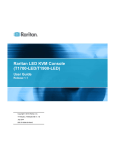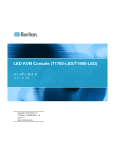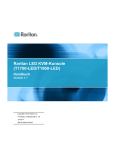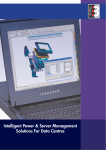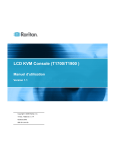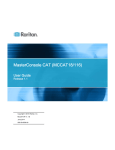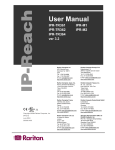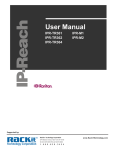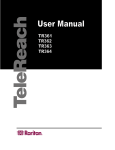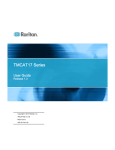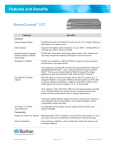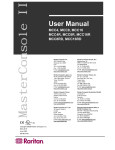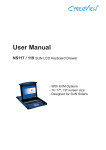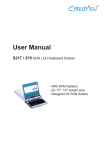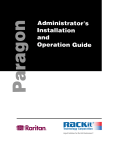Download T1700-LED User Guide
Transcript
T1700-LED LCD Console User Guide Release 1.0 Copyright © 2013 Raritan, Inc. T1700LED-0A-v1.0-E March 2013 255-37-0002-00 RoHS This document contains proprietary information that is protected by copyright. All rights reserved. No part of this document may be photocopied, reproduced, or translated into another language without express prior written consent of Raritan, Inc. © Copyright 2013 Raritan, Inc. All third-party software and hardware mentioned in this document are registered trademarks or trademarks of and are the property of their respective holders. FCC Information This equipment has been tested and found to comply with the limits for a Class A digital device, pursuant to Part 15 of the FCC Rules. These limits are designed to provide reasonable protection against harmful interference in a commercial installation. This equipment generates, uses, and can radiate radio frequency energy and if not installed and used in accordance with the instructions, may cause harmful interference to radio communications. Operation of this equipment in a residential environment may cause harmful interference. VCCI Information (Japan) Raritan is not responsible for damage to this product resulting from accident, disaster, misuse, abuse, non-Raritan modification of the product, or other events outside of Raritan's reasonable control or not arising under normal operating conditions. If a power cable is included with this product, it must be used exclusively for this product. Contents Important Safeguards v What the Warranty Does Not Cover .............................................................................................. v Safety Instructions ........................................................................................................................ vi Chapter 1 Introduction 1 Package Content ........................................................................................................................... 1 Structure Diagram.......................................................................................................................... 1 Chapter 2 Installation 3 Before Installation .......................................................................................................................... 3 Installing the T1700-LED ............................................................................................................... 4 Connecting a Server or KVM Switch ............................................................................................. 7 Connection to a KVM Switch ............................................................................................... 7 Connection to a Server........................................................................................................ 8 Connecting an External USB Device (Optional) .......................................................................... 10 Chapter 3 Operation 12 Locking or Unlocking the T1700-LED .......................................................................................... 12 Operating the T1700-LED............................................................................................................ 13 Closing the T1700-LED ............................................................................................................... 14 Chapter 4 Using the OSD Menu 15 Onscreen Display Operation........................................................................................................ 15 Onscreen Menu ........................................................................................................................... 16 Auto Adjust ........................................................................................................................ 16 Luminance ......................................................................................................................... 17 Management...................................................................................................................... 17 Color .................................................................................................................................. 18 OSD ................................................................................................................................... 19 Language........................................................................................................................... 19 Recall................................................................................................................................. 20 Information......................................................................................................................... 20 iii Contents Selecting the Video Source (Optional)......................................................................................... 21 Appendix A Specifications 22 Technical Specifications .............................................................................................................. 22 Environmental Specifications....................................................................................................... 23 Dimensions .................................................................................................................................. 23 Appendix B Ground Screw iv 24 Important Safeguards Read all these instructions carefully before you use the device. Save this manual for future reference. What the Warranty Does Not Cover Any product, on which the serial number has been defaced, modified or removed. Damage, deterioration or malfunction resulting from: Accident, misuse, neglect, fire, water, lightning, or other acts of nature, unauthorized product modification, or failure to follow instructions supplied with the product. Repair or attempted repair by anyone not authorized by us. Any damage of the product due to shipment. Removal or installation of the product. Causes external to the product, such as electric power fluctuation or failure. Use of supplies or parts not meeting our specifications. Normal wear and tear. Any other causes which does not relate to a product defect. Removal, installation, and set-up service charges. v Important Safeguards Safety Instructions vi Unplug equipment before cleaning. Don't use liquid or spray detergent; use a moist cloth. Keep equipment away from excessive humidity and heat. Preferably, keep it in an air-conditioned environment with temperatures not exceeding 40º Celsius (104º Fahrenheit). When installing, place the equipment on a sturdy, level surface to prevent it from accidentally falling and causing damage to other equipment or injury to persons nearby. When the LCD console is in an open position, do not cover, block or in any way obstruct the gap between it and the power supply. Proper air convection is necessary to keep it from overheating. Arrange the equipment's power cord in such a way that others won't trip or fall over it. If you are using a power cord that didn't ship with the equipment, ensure that it is rated for the voltage and current labeled on the equipment's electrical ratings label. The voltage rating on the cord should be higher than the one listed on the equipment's ratings label. Observe all precautions and warnings attached to the equipment. If you don't intend to use the equipment for a long time, disconnect it from the power outlet to prevent being damaged by transient over-voltage. Keep all liquids away from the equipment to minimize the risk of accidental spillage. Liquid spilled on to the power supply or on other hardware may cause damage, fire or electrical shock. Only qualified service personnel should open the chassis. Opening it yourself could irreparably damage the equipment and invalidate its warranty. If any part of the equipment becomes damaged or stops functioning, have it checked by qualified service personnel. Chapter 1 Introduction The User Guide introduces Raritan T1700-LED, a 1U rackmount LCD console, which can be used to operate a KVM switch or server in the data center or server room. This product features an LED-backlit LCD monitor and a DVI port. In This Chapter Package Content .......................................................................................1 Structure Diagram .....................................................................................1 Package Content The T1700-LED comes with standard parts shown below. Check and make sure they are included and in good condition. If anything is missing or damaged, contact Raritan or the local vendor immediately. T1700-LED LCD console Rackmount brackets * Mounting depth adjustable from 500 to 688 mm 3-in-1 KVM cable (VGA, USB, PS/2) DVI cable Quick Setup Guide Warranty card Power cord Drawer key (to unlock the console) Structure Diagram 1 Chapter 1: Introduction 1. Touchpad 2. Keyboard 3. Indicators for Num Lock, Caps Lock and Scroll Lock status 4. LCD monitor 5. OSD buttons and indicator lamp 6. Adjustable mounting brackets 7. Ergonomic concave handle 8. Lock 2 Chapter 2 Installation In This Chapter Before Installation......................................................................................3 Installing the T1700-LED ...........................................................................4 Connecting a Server or KVM Switch .........................................................7 Connecting an External USB Device (Optional)......................................10 Before Installation It is very important to locate the T1700-LED in a suitable environment. The surface for placing and fixing the T1700-LED should be stable and level or mounted into a suitable cabinet. Make sure the place has good ventilation, is out of direct sunlight, away from sources of excessive dust, dirt, heat, water, moisture, and vibration. Convenience for connecting the T1700-LED to the related facilities should be well considered too. 3 Chapter 2: Installation Installing the T1700-LED To rack-mount the T1700-LED: 1. Slightly loosen the fasteners on the brackets, adjust the length of the brackets to match the mounting depth of the rack, and then tighten the fasteners. 4 Chapter 2: Installation 2. Fastens the brackets to the rack rails securely with your own screws or cage nuts. 3. Slide the T1700-LED LCD console between the brackets as shown below. 5 Chapter 2: Installation 4. Fasten the T1700-LED to the rack. The diagram below illustrates how the T1700-LED moves between the brackets. 6 Chapter 2: Installation Connecting a Server or KVM Switch The T1700-LED can be connected to either a KVM (keyboard/video/mouse) switch or a server. Always use the Raritan-provided 3-in-1 cable to make the connection. A DVI cable is also required if the server's video port is a DVI port or if you prefer using the DVI port. Connection to a KVM Switch You can make a connection to any KVM switch via USB or PS/2 as illustrated below. Then use the T1700-LED to access the KVM switch and the equipment connected to the KVM switch. Do NOT connect both USB and PS/2 connectors to the KVM switch simultaneously. If connecting Raritan's MCCAT28/216 KVM switch, the T1700-LED only supports the PS/2 connection. Warning: The T1700-LED does NOT support Raritan's MasterConsole II (MCC) KVM switch so do not connect any MCC device to it. USB connection PS/2 connection 7 Chapter 2: Installation 3-in-1 KVM cable KVM switch Connection to a Server You can make a connection to any server via USB, PS/2 or a combination of DVI and USB or PS/2 interface. Do NOT connect both USB and PS/2 connectors to the server simultaneously. USB connection PS/2 connection 3-in-1 KVM cable Server 8 Chapter 2: Installation Connections via DVI and USB or PS/2 -- OR -- 3-in-1 KVM cable DVI cable Server Tip: If both DVI and VGA ports are available on the server, you may make connections to both ports, and then press the DOWN/SOURCE button to switch between different video sources. 9 Chapter 2: Installation Connecting an External USB Device (Optional) The T1700-LED provides an additional USB interface that functions as the extension of the USB-A interface of the server connected to the T1700-LED, therefore facilitating the use of an external USB device with the server, such as a USB keyboard, mouse or a USB disk. This additional USB interface comprises a USB-B port on the rear panel of the T1700-LED and a USB-A port on the front panel. The USB connection between the server and the T1700-LED is required in order to use this USB interface. To connect an external USB device: 1. Use a regular USB-A to USB-B cable to connect the T1700-LED and the server. a. Plug the USB-A connector into one of the available USB-A ports on the T1700-LED. b. Plug the USB-B connector into the USB-B port on the rear side of the T1700-LED. Note: Raritan does not provide the USB-A to USB-B cable. 2. Connect any USB device to the front panel USB-A port of the T1700-LED. 10 Chapter 2: Installation Now the server should detect the connection of this external USB device. If necessary, install the driver for the detected USB device. 11 Chapter 3 Operation In This Chapter Locking or Unlocking the T1700-LED......................................................12 Operating the T1700-LED .......................................................................13 Closing the T1700-LED ...........................................................................14 Locking or Unlocking the T1700-LED The T1700-LED has a lock to the right side. When locked, you cannot draw this product out of the rack. Use the drawer key or a coin-shaped object to turn the lock. To unlock this product, turn the lock counterclockwise. To lock this product, turn the lock clockwise. 12 Chapter 3: Operation Operating the T1700-LED 1. Gently pull the concave handle toward the front of the LCD. 2. Flip up the LCD to a suitable angle. 3. Operate the T1700-LED. For information on LCD buttons and onscreen menu, see Using the OSD Menu (on page 15). 13 Chapter 3: Operation Closing the T1700-LED 1. Locate a gray-arrow release button on two sides of the T1700-LED device. 2. Push both gray-arrow buttons in the direction as indicated by the arrow head before pushing the T1700-LED into the rack. 3. Keep pushing the gray-arrow buttons until the T1700-LED is completely moved into the rack. 14 Chapter 4 Using the OSD Menu You can customize the video properties of the built-in LCD display, such as colors and image position, and the OSD settings, such as the language displayed in the OSD, by changing the settings of the OSD menu. In This Chapter Onscreen Display Operation ...................................................................15 Onscreen Menu .......................................................................................16 Selecting the Video Source (Optional) ....................................................21 Onscreen Display Operation Buttons Function POWER Power on/off the LCD panel. The LCD indicator lamp indicates the current power on/off status. Light off = LCD power off Blue = LCD power on UP/AUTO This button has two functions: When no OSD is displayed, pressing this button optimizes the visual settings. While the OSD is being displayed, pressing this button moves up the selection. 15 Chapter 4: Using the OSD Menu Buttons Function DOWN/SOURCE This button has two functions: MENU EXIT When no OSD is displayed, this button is used to select the video source - VGA or DVI. While the OSD is being displayed, pressing this button moves down the selection. This button has two functions: When no OSD is displayed, pressing this button triggers the OSD menu. While the OSD is being displayed, this button functions as the Enter key and can be used to confirm the selection. Quit the current OSD setting page or the OSD menu. Onscreen Menu The onscreen menu contains eight items: four are related to the visual quality, two are related to the OSD settings, one is to show the current video information, and one is used to restore the settings to factory defaults. Auto Adjust Auto Adjust: Fine tune the video signals to eliminate waviness and distortion. An "Auto Adjusting" message is displayed during the process. 16 Chapter 4: Using the OSD Menu Luminance Brightness: Make the screen image brighter or darker. Contrast: Adjust the difference between the background black level and foreground white level. Black Level: Adjust the black level of the screen image. Sharpness: Fine tune the sharpness of the screen image. Management H. Position: Move the screen image left or right. V. Position: Move the screen image up or down. 17 Chapter 4: Using the OSD Menu Pixel Clock: Adjust the clock/pitch to synchronize the sampling clock of the LCD to the pixel clock of the connected equipment. This adjustment is needed only for VGA signals when Auto Tune does not get the optimum video performance and vertical dark bands are visible on the screen. Phase: Adjust the phase to synchronize the frequency settings of the LCD to the frequency output of the connected equipment. Perform this adjustment only when horizontal streaking is seen on the screen. Color Select the screen color temperatures. The factory default is 6500K. 9300: Add blue to the screen image, making the white cooler. 6500: Add red to the the screen image, making the white warmer. 5400: Add green to the screen image, making the white cooler. User Preset: Adjust red, green and blue colors respectively. 18 Chapter 4: Using the OSD Menu OSD H. Position: Adjust the OSD's horizontal position. V. Position: Adjust the OSD's vertical position. OSD Time: Set the time duration in seconds for which the OSD remains visible after the last button is pressed. The factory default is 10 seconds. Language Select the language in which the OSD menu is displayed. Available options include English, Chinese, Japanese, Deutsch, Français, Español, Italiano, Korean, Portuguese and Russian. 19 Chapter 4: Using the OSD Menu Recall Recall Color: Reset all colors to factory defaults. Recall All: Reset all settings to factory defaults except for the language setting. A confirmation message appears after selecting either Recall option. Press UP/AUTO to select Yes and then press MENU to confirm the operation. Information Display Information: Display the current resolution and frequency information on the screen. 20 Chapter 4: Using the OSD Menu Selecting the Video Source (Optional) If both VGA and DVI ports are available on the server, you can make connections to both ports through the 3-in-1 and DVI cables respectively. When both video ports are used, you can switch between these two video sources by operating the OSD. To switch between VGA or DVI signals: 1. Press the DOWN/SOURCE button on the LCD panel. An OSD appears, showing two options - VGA and DVI. 2. Press the UP/AUTO or DOWN/SOURCE button to select a video source. 3. Press MENU to confirm your selection. 21 Appendix A Specifications In This Chapter Technical Specifications ..........................................................................22 Environmental Specifications ..................................................................23 Dimensions ..............................................................................................23 Technical Specifications Item Form factor Diagonal size Max. resolution Brightness (cd/m²) Color support Contrast ratio (typ.) Viewing angle (H/V) Display area (mm) Tr response time (ms) VGA signal input Sync. type Resolution Description 1U rack mounting on slide-out rails 17.3" TFT 1920 x 1080 300 262,144 650:1 70° x 70° 337 x 270 2 Analog RGB, 0.7Vp-p Separate H/V, Composite, SOG 720 x 400, 70Hz (IBM VGA) 640 x 480, 60Hz (IBM VGA) 640 x 480, 72 / 75Hz (VESA) 800 x 600, 56 / 60 / 72 / 75Hz (VESA) 1024 x 768, 60 / 70 / 75Hz (VESA) 1152 x 864, 75Hz (VESA STD) 1280 x 1024, 60 /70Hz (VESA STD) 1280 x 1024, 75Hz (VESA) 1440 x 900, 60 / 75Hz (VESA STD) 22 Appendix A: Specifications Item Description 1680 x 1050, 60Hz (VESA STD) 1920 X 1080, 60Hz (VESA STD) Plug & play DDC Console port (combo) EDID 1.3 3-in-1 DB-15 connector for VGA / keyboard / mouse Support USB & PS/2 servers or KVM switches Auto-sensing 100 to 240VAC, 50 / 60Hz Power input Power consumption Max. 12.2 Watt, Standby 3.2 Watt Multi-platform - Mix PCs, SUNs, IBMs, HPs Compatibility Regulation approval FCC, CE, UL Environmental Specifications Item Description 0° to 40°C degrees Operation -5° to 60°C degrees Storage Relative humidity Shock Vibration 5~90%, non-condensing 10G acceleration (11ms duration) 5~500Hz 1G RMS random vibration Dimensions Model T1700-LED Product dimension (W x D x H) 434 x 569 x 43.5 mm Packing dimension (W x D x H) 742 x 602 x 178 mm Net weight 12 kg Gross weight 18 kg 17.1 x 22.4 x 1.71" 29.2 x 23.7 x 7.0" 26.5 lb 39.7 lb 23 Appendix B Ground Screw If you want to prevent any electrical shock, you can use the ground screw on the rear panel to provide a safe electrical path to the ground. To prevent any potential shock hazard: Connect the ground screw to a wiring system or wiring device. 24






























